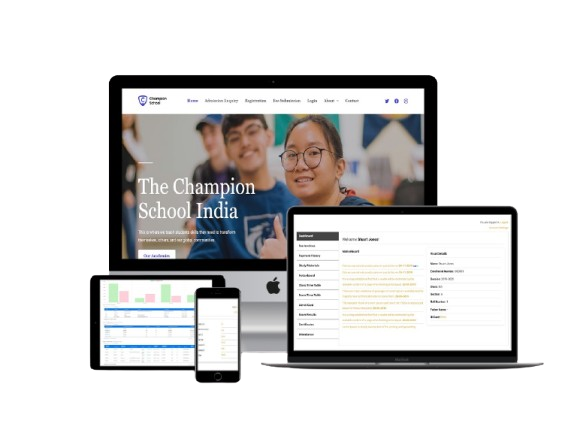Table of Contents
- Introduction
- Why Every School Needs a Website: 12 Practical Reasons for 2025
- 1. First impressions now happen online — and fast
- 2. Admissions and enquiries convert better online
- 3. Parent engagement becomes easier and measurable
- 4. Reputation and discovery (SEO) increases enrolment
- 5. Showcase learning outcomes and curriculum
- 6. Virtual tours and multimedia show culture
- 7. Crisis communication and updates are immediate
- 8. Operational efficiencies and lower administrative cost
- 9. Data-driven decisions and analytics
- 10. Inclusivity and accessibility by design
- 11. Competitive edge for recruitment and partnerships
- 12. Future-proofing through digital transformation
- Why Every School Needs a Website — must-have features checklist (2025)
- How to Structure Content — SEO and UX that Converts
- A small table: DIY vs Template vs Full-Service (quick ROI view)
- Design & Accessibility — make it mobile-first and inclusive
- Performance, Security & Compliance
- Content Ideas & Editorial Calendar (ready-to-use)
- Implementation Roadmap — from concept to launch (90 days)
- Measuring Success — KPIs that matter
- Cost & ROI — realistic expectations
- Why Every School Needs a Website: Case study (mini)
- Content governance & team roles (who does what)
- 10 Practical Tips to Keep Your School Website Effective in 2025
- FAQs
- Conclusion — why every school needs a website
Introduction
Parents, students, and local communities judge schools online first. In 2025, that “first impression” usually happens on a phone or laptop. Yet many schools still rely on noticeboards, PDFs, or an outdated site. That causes lost admissions, frustrated parents, and missed admission opportunities. This is why every school needs a website: a modern site solves those pain points. It attracts parents, improves communication, and powers digital transformation.
A clear website reduces calls to the office. It speeds up admissions. It strengthens safety and compliance. Most importantly, it lets your school control the narrative. In the sections below you’ll find practical reasons, must-have features, SEO tactics, a roadmap to launch, and ready-to-use content ideas. Use this guide to build or upgrade your school’s web presence in 2025.
Why Every School Needs a Website: 12 Practical Reasons for 2025
Focused, actionable reasons that school leaders can present to trustees and Parent and Teacher Associations.
1. First impressions now happen online — and fast
Your website is the digital front door. Prospective parents often make quick judgments from the homepage, photos, and admissions info. A professional, up-to-date website builds trust. It answers top questions before the first call. Remember: why every school needs a website starts with trust.
2. Admissions and enquiries convert better online
Online forms, FAQs, downloadable prospectuses, and digital open-day signups make admissions smoother. Schools that digitize applications see faster response times and lower admin costs. A good site reduces friction and increases completed applications.
3. Parent engagement becomes easier and measurable
A central website with a news feed, calendar, and messaging lowers email noise. Parent portals and resources give families confidence. You can measure engagement via pageviews, form submissions, and visit duration — useful evidence for school governors.
4. Reputation and discovery (SEO) increases enrolment
A school that appears in local search results attracts more local families. SEO-friendly content lets you answer common queries like “best primary school near me” or “how to apply for admission”. That’s exactly why every school needs a website with strong SEO.
5. Showcase learning outcomes and curriculum
Publish clear curriculum pages, sample lesson plans, and student achievements. This transparency helps parents compare schools. Schools with visible outcomes are perceived as more accountable.
6. Virtual tours and multimedia show culture
Photos and short videos convey the school atmosphere better than words. Virtual tours let out-of-area parents explore your campus. Add student voice via testimonials to humanize the brand.
7. Crisis communication and updates are immediate
In emergencies, a website is a reliable hub to post official updates. Push communications, PDF notices, and SMS integrations reduce misinformation and phone calls.
8. Operational efficiencies and lower administrative cost
Automated forms, fee portals, event sign-ups, and staff directories save time. The site becomes a single source of truth for policy documents, calendars, and staff contacts.
9. Data-driven decisions and analytics
Website analytics show what parents truly care about — admissions, fees, curriculum, safety. That data guides marketing and improvement plans.
10. Inclusivity and accessibility by design
A school website that is accessible not only makes life easier for families with disabilities but also shows the school is acting responsibly — both by following the law and by doing the right thing.
11. Competitive edge for recruitment and partnerships
A strong web presence attracts qualified staff and community partners. It helps with fundraising, sponsorships, and collaborative programmes.
12. Future-proofing through digital transformation
A website acts as the platform for new digital tools — LMS, online fee systems, virtual classrooms. That’s the long-term payoff and a key reason why every school needs a website.
Why Every School Needs a Website — must-have features checklist (2025)

Use this checklist when briefing your vendor or internal team.
- Clear homepage with mission and quick contact.
- Mobile-first responsive design. (mobile-first school website)
- Admissions hub: forms, fee info, important dates, online payments.
- Virtual tour and media gallery (virtual school tour).
- Parent portal and secure login (school communication portal).
- News & calendar with event subscription.
- Curriculum pages & learning outcomes.
- Staff directory and easy search.
- Accessibility features (WCAG 2.1 AA minimum).
- SEO fundamentals: meta tags, schema, local SEO.
- Analytics (Google Analytics/GSC) and conversion tracking.
- Security: HTTPS, regular backups, role-based access.
- CMS that non-technical staff can update.
How to Structure Content — SEO and UX that Converts
Good websites answer user intent. Write content for parents, students, and regulators. Use short paragraphs, clear CTAs, and schema markup for events and staff.
Content blocks to include on your main pages:
- Hero statement with a clear CTA: “Book a campus tour” or “Apply now”.
- 3 quick stats (e.g., small class sizes, pass rates, student-teacher ratio).
- Admissions summary with prominent link to the admissions hub.
- Latest news & success stories (updated weekly if possible).
- Contact & map (structured data for local SEO).
SEO tips for schools:
- Target long-tail keywords (e.g., “best primary school near [town]”). Long-tail keywords deliver high intent visitors. (Tip: long-tail is easier to rank locally.)
- Use local schema and Google Business Profile.
- Publish FAQs addressing parents’ top queries.
- Keep page load under 2 seconds; compress images and use modern formats.
A small table: DIY vs Template vs Full-Service (quick ROI view)
| Option | Speed | Cost | Quality | Best for |
|---|---|---|---|---|
| DIY (free builders) | Fast | Low | Limited | Schools with tiny budgets and staff time |
| Template + CMS | Medium | Medium | Good | Small schools wanting control |
| Full-service (agency) | Slower | Higher | Best | Schools that want polished brand & support |
Note: LegacyEdTech offers full-service packages that combine strategy, design, and training. See our services at LegacyEdTech for school website packages.
Design & Accessibility — make it mobile-first and inclusive
More than half of traffic to school sites is mobile. Prioritize big buttons, readable fonts, and a clear menu. Use high-contrast colors and alt text for images. Ensure keyboard navigation and screen-reader compatibility.
Image alt text suggestions (use LSI keywords):
- “virtual school tour of playground and classrooms” (alt)
- “school website design homepage showing admissions CTA” (alt)
- “parents viewing online admissions form on mobile” (alt)
- “teacher-led interactive classroom — school website features” (alt)
Performance, Security & Compliance
Fast sites rank better. Secure sites build trust.
Essential tech actions:
- Use HTTPS and HSTS.
- Regular backups and patching.
- Role-based CMS access and strong passwords.
- GDPR/Local data compliance for parent/student data.
- Routine accessibility audits.
Content Ideas & Editorial Calendar (ready-to-use)
Post consistently. Here’s a simple monthly rhythm you can follow:
- Week 1: Admissions spotlight — explain the application process.
- Next Week 2: Curriculum corner — highlight a subject and sample lesson.
- Followed by Week 3: Parent voice — testimonial or interview.
- Lastly Week 4: Student showcase — project, sports, or arts.
Quick post ideas for SEO:
- “How to apply to [School Name] in 2025” (admissions long-tail)
- “Top 10 questions parents ask about [town] schools”
- “A virtual tour of our labs and library”
Implementation Roadmap — from concept to launch (90 days)
Phase 1 — Weeks 1–2: Discovery
- Plan a Design for your site.
- Identify top 10 pages and top 10 user queries.
- Choose Service Provider and hosting.
Phase 2 — Weeks 3–6: Design & Content
- Wireframes and brand templates.
- Write key pages: Homepage, Admissions, Curriculum, Contact.
- Add accessibility and mobile-first test cases.
Phase 3 — Weeks 7–10: Build & Test
- Development, integrations (forms, payments, GSC), analytics.
- Speed and accessibility testing.
- Staff training for CMS.
Phase 4 — Week 11–12: Launch & Promote
- Announce on social channels, PTA, and local groups.
- Run a 4-week content push to showcase the new site.
Post-launch
- Monthly analytics review and content updates.
- Quarterly security and accessibility reviews.
Measuring Success — KPIs that matter
- Completed admission forms (conversions).
- Website sessions from local search (organic local traffic).
- Time on page for admissions & curriculum pages.
- Newsletter signups and event RSVPs (responses).
- Support ticket volume (should fall after launch).
Cost & ROI — realistic expectations
A well-built school website reduces phone traffic and administrative hours. It also increases completed applications and improves brand perception. Typical cost bands (2025 market):
- Low-cost template: ₹20,000–₹60,000 (one-time) + yearly hosting.
- Mid-range custom site: ₹1.5–4 Lakh (includes CMS + training).
- Full-service (strategy + ongoing support): ₹4–12 Lakh (annual retainer optional).
ROI example: If a site increases completed admissions by 5–10 applicants and each admission brings school fees of ₹1,00,000 per year, the site pays for itself quickly.
Why Every School Needs a Website: Case study (mini)
Scenario: A medium-sized K-12 school in a City
Problem: Outdated site, low inquiries, repeated calls to admin.
Solution: Launch a mobile-first site with admissions hub, virtual tour, and local SEO.
Outcome (after 6 months): 35% increase in site visits, 22% rise in completed online enquiries, 40% reduction in admission office calls. That’s why every school needs a website — it changes daily operations and perception.
If you want a partner, LegacyEdTech builds mobile-first, accessible school websites with CMS training and monthly support. Book a free discovery call with our school team at https://legacyedtech.in/free-consultation. We design for admissions, parent engagement, and measurable results.
Content governance & team roles (who does what)
- Principal / Head: Approves messaging and key policies.
- Communications lead / Admin: Publishes news and maintains calendar.
- Teacher champions: Provide classroom content.
- IT / vendor: Maintains CMS, security, backups.
Train staff: 2–3 CMS workshops (1–2 hours each) should be enough for daily updates.
10 Practical Tips to Keep Your School Website Effective in 2025
- Update admissions pages before application season.
- Use short video clips instead of long films.
- Keep forms short; ask only for essential info first.
- Monitor search queries and add content for top queries.
- Use simple CTAs: Book, Apply, Call.
- Schedule weekly news posts — consistency beats occasional perfection.
- Run an accessibility audit twice a year.
- Archive old content — keep the site lean.
- Protect admin accounts with multi-factor authentication.
- Have a small budget for ad boosts if you need quick visibility.
FAQs
What are the essential school website features for admissions?
Admissions hub, online forms, downloadable prospectus, clear fees page, event signup for open days, and a contact form that converts.
How much does a professional school website cost?
Costs vary. Expect templates for lower budgets and full-service custom builds for higher budgets. Consider maintenance and hosting in yearly budgets.
Why every school needs a website in 2025 — isn’t social media enough?
Social media helps with reach, but a website owns your content and provides searchable, long-form details (admissions info, policies, curriculum). A website and social platforms work together — not instead of each other.
How does a school website improve parent engagement?
A central website reduces email noise, phone calls, parent in-person visit and gives parents on-demand access to calendars, newsletters, and resources — improving satisfaction and trust.
How quickly can we launch a mobile-first school website?
With a focused plan and content ready, a basic mobile-first site can launch in 6–10 weeks; a full custom site with integrations might take 10–12 weeks.
Conclusion — why every school needs a website
In 2025, any school that wants to grow, improve parent engagement, and run efficiently must own its digital front door. The single clearest step a school can take is to build or modernize a professional website. That is exactly why every school needs a website: it increases trust, improves admissions conversions, and acts as the platform for your school’s long-term digital transformation. If you’re ready, LegacyEdTech will help you plan, build, and measure a website that works.
Are you ready to modernize your school’s digital front door? Contact LegacyEdTech for a free consultation and bespoke school website package.







